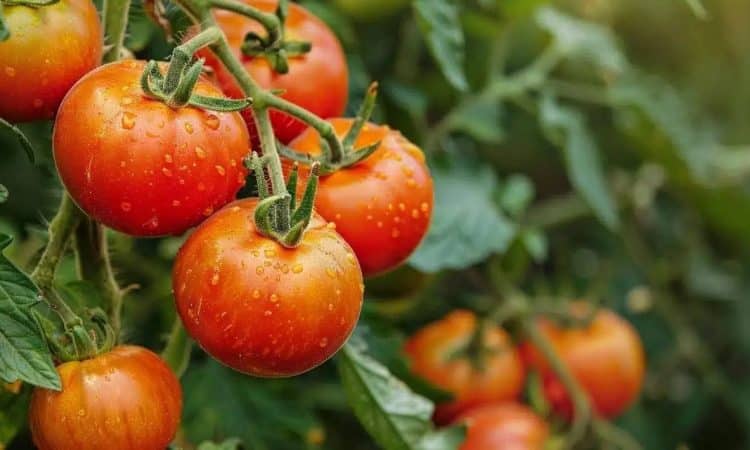How to Know When to Harvest Tomatoes: 3 Key Signs for Juicy Tomatoes on Your Plate

Harvesting tomatoes in the vegetable garden is a crucial moment for any home gardener. Knowing when to pick these tasty fruits can mean the difference between a delicious harvest and culinary disappointment. Fortunately, there are reliable clues to help you determine the ideal time to pick. Let’s discover the signs that will guide you to perfectly ripe, tasty tomatoes.
Color: The First Indicator of Ripeness
Color is undoubtedly the most obvious clue when it comes to determining whether your tomatoes are ready to harvest. However, you shouldn’t rely solely on this visual aspect.
Uniformity of hue is an essential criterion. A ripe tomato generally has a uniform color across its entire surface. Depending on the variety you’ve planted, this color can be:
- Bright red
- Golden yellow
- Bright orange
- Deep green (for specific varieties)
It’s important to note that some tomato varieties retain traces of green even when ripe. In this case, rely more on texture than color alone.
However, don’t leave your tomatoes too long on the vine once they’ve reached their optimum color. Over-ripening can lead to a soft texture and attract unwanted pests to your garden. Maximizing your harvest in August requires constant vigilance as to the ripeness of your vegetables.
Firmness to the Touch: A Decisive Criterion
The second key indicator of when to harvest your tomatoes is their firmness. A ready-to-pick tomato must have a perfect balance between softness and firmness.
How to assess firmness? Apply gentle pressure with your thumb on the surface of the tomato. A perfectly ripe tomato will yield slightly under pressure, yet still retain a certain resistance. Here’s a quick guide:
| Texture | State of Ripeness | Recommended Action |
|---|---|---|
| Very hard | Not yet ripe | Leave standing |
| Firm with slight softness | Medium ripe | Harvest |
| Soft | Overripe | Consume quickly |
Ideal firmness guarantees juicy, flavorful tomatoes. It’s also the optimum time to pick if you plan to store your tomatoes for a few days before consumption. Harvesting too early can result in bland fruit, while late harvesting can lead to rapid spoilage.
It’s vital to note that some experienced gardeners, such as gardening enthusiast Thomas Jefferson, advocated harvesting tomatoes slightly before they were fully ripe. This technique preserves texture and avoids insect attack or disease, while allowing the fruit to finish ripening off the vine.
Ease of Stem Detachment
The third and final crucial factor in determining the right moment to harvest your tomatoes is the ease with which they detach from their stalks. This often overlooked detail is an excellent indicator of ripeness.
How to check this criterion? Gently grasp the tomato and rotate it slightly. If it detaches easily, it’s ready to be picked. On the other hand, if you have to force or twist excessively, it’s best to wait a little longer.
This method has several advantages:
- It ensures that the tomato is at its peak of ripeness.
- It ensures the optimum development of natural sugars.
- It reduces the risk of injuring the plant during picking.
It’s worth noting that some tomato varieties, notably cherry tomatoes, may require the use of scissors for a clean harvest. In this case, be sure to cut the stalk as close to the fruit as possible to avoid damaging the plant.
Optimizing Your Harvest for Tasty Tomatoes
Now that you know the three key clues to determining the right time to harvest your tomatoes, it’s important to understand how to optimize this process to ensure tasty fruit and a healthy plant.
Harvest frequency plays a crucial role. It’s a good idea to check your tomato plants daily, especially during the hot summer months. Regular harvesting stimulates the production of new fruit and avoids overloading the plants.
Don’t forget that some vegetables require daily watering, and tomatoes are one of them, especially during hot spells. Regular watering contributes to the overall health of the plant and the quality of the fruit.
Finally, the method of post-harvest storage is just as important as the time of picking. For tomatoes picked slightly before ripening, place them in a warm, well-ventilated area, out of direct sunlight. They’ll continue to ripen naturally, giving you fruit that’s perfect for summer salads or homemade sauces.
By following these tips and keeping an eye on your tomatoes’ signs of ripeness, you can be sure of a plentiful, tasty harvest all season long. Gardening, as Voltaire so aptly put it, is not only a source of pleasure, but also a way of “cultivating your inner garden,” in harmony with nature.
Main Ideas
- Ripeness: Observe uniform color, check firmness, and test for stalk detachment.
- Tomato color: Look for uniform hue according to variety: red, yellow, orange, or green.
- Firmness test: Apply light pressure with your thumb; tomatoes should be soft but resistant.
- Stem detachment: Gently grasp the tomato and rotate slightly to check detachment.
- Optimize harvesting: Check plants daily, harvest regularly to stimulate fruit production.

